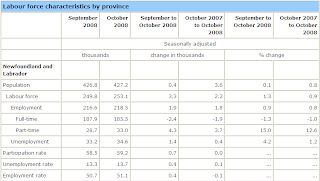+Employment+1976-2008.png)
Newfoundland and Labrador labour markets continued to weaken in December as seasonally adjusted person-years of employment fell to just over 217 thousand. This weakness somewhat mirrors the recession that is occurring throughout the world but in our case it reflects the decreasing demand for our natural resource exports and associated primary manufacturing.
An interesting feature of our employment figures are that they include LDCers (Long Distance Commuters) who are permanently resident here by work in Alberta. Recent stories on CBC have featured these workers being laid off and facing hardship as their current lifestyle depends on high-paying jobs which just vanished.
This downward trend in "employment" which began around the middle of 2008 is expected to pick up speed as during 2009. Abitibi-Bowater workers from the Grand Falls-Windsor mill will begin to show up in the January LFS figures as will workers associated with operations that supply the mill. Just as people like to talk about a multiplier effect associated with large project development the same effect ultimately exists when these operations close down. In addition, fewer workers putting in less hours of overtime coupled with the cutailed consumption of laid-off workers will further curtail employment.
Readers should carefully watch the fishing sector for two reasons: firtsly, the sales and the price of the industries products are very sensitive to downturns in the economy and secondly, parts of our provincial industry are tied to the Icelandic industry and banks and that economy has been experiencing a full-blown depression.
In some ways one might think that the Newfoundland and Labrador economy is more immune to the international recession since the public sector plays a larger role. However, the Provincial Government is facing large wage settlements coupled with very diminished oil revenues. Government may quietly allow employment levels to fall as workers retire under the banner of promoting increased efficiency. The Finance Minister has already noted the need for such efficiency. Such actions if they were to occur would aggrevate labour market opportunities especially for recent university graduates.
Unfortunately all this adds up to a rather gloomy prediction that the same seasonally adjusted employment figure in December 2009 will be about 212,000.


